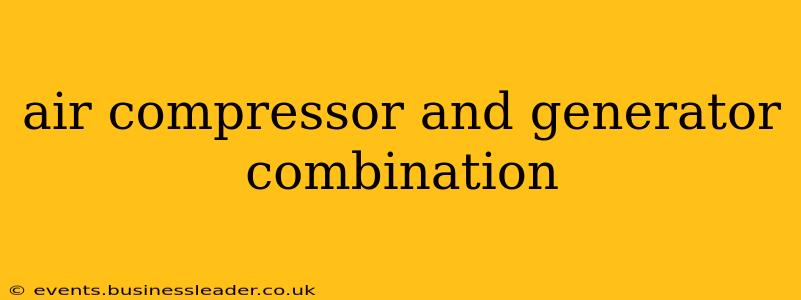Combining an air compressor and a generator offers a powerful and versatile solution for various applications, from powering tools on remote job sites to providing essential services during power outages. This combination eliminates reliance on grid power and offers unmatched flexibility. This article will explore the benefits, considerations, and practical applications of this powerful duo.
What are the Benefits of Combining an Air Compressor and a Generator?
The primary benefit lies in independence from the power grid. This is crucial for situations where electricity isn't readily available, such as:
- Remote work locations: Construction sites, farms, and forestry operations often lack reliable power sources. A generator-powered air compressor allows work to continue uninterrupted.
- Emergency preparedness: During power outages, having a generator-powered air compressor can be vital for inflating emergency equipment, running pneumatic tools for repairs, or powering essential life support systems (depending on the size and application).
- Off-grid living: Individuals living off the grid benefit immensely from this self-sufficient power solution.
Beyond independence, combining these two machines offers:
- Increased efficiency: A dedicated generator provides consistent power, ensuring the air compressor operates at its optimal performance level without power fluctuations.
- Portability: Depending on the size, generator-compressor combos can be relatively portable, allowing for easy transport to different work locations.
- Cost-effectiveness (long-term): While the initial investment can be higher than separate units, the long-term cost savings from increased efficiency and reduced downtime can be significant.
What Size Generator Do I Need for My Air Compressor?
Choosing the right generator size is critical. Underpowering your compressor can lead to overheating and damage, while oversizing leads to unnecessary cost. You need to consider the compressor's starting and running wattage. The starting wattage is significantly higher than the running wattage. The generator must be able to handle the peak starting wattage.
To determine the appropriate generator size:
- Check your air compressor's specifications: Locate the nameplate on your compressor to find the horsepower (HP) and amps. Use an online HP to watts converter to calculate the wattage. Remember, this will likely be the running wattage.
- Determine the starting wattage: The starting wattage is typically 2-3 times higher than the running wattage.
- Choose a generator with a surge capacity: Ensure your generator's surge capacity (the maximum power it can deliver momentarily) exceeds your compressor's starting wattage.
- Add a safety margin: It's advisable to select a generator with a slightly higher wattage than calculated to account for potential variations in voltage and efficiency.
For example, if your compressor has a running wattage of 2000W, and the starting wattage is 6000W, you'll need a generator with at least a 6000W surge capacity, ideally slightly more.
What are the Different Types of Generator-Compressor Combinations?
There are primarily two types of setups:
- Integrated Units: These are single units where the generator and compressor are combined in one chassis. They are compact and easy to transport but may offer less flexibility in terms of choosing individual components.
- Separate Units: This setup involves using a separate generator and a separate air compressor. This approach offers more flexibility in component selection and allows for upgrades or replacements of individual components independently.
How Much Does a Combined Air Compressor and Generator System Cost?
The cost varies significantly based on the size and features of both the generator and the compressor. Small, portable units can be found for a few thousand dollars, while larger, more powerful systems can cost tens of thousands. Always consider your specific needs and budget when making a purchase.
How Do I Maintain My Generator-Powered Air Compressor System?
Regular maintenance is crucial to ensure the longevity and efficiency of your system. This includes:
- Regular oil changes: Change the oil in both the generator and the compressor according to the manufacturer's recommendations.
- Air filter cleaning/replacement: Clean or replace the air filter of the compressor regularly to prevent dust and debris from entering and damaging the system.
- Spark plug inspection: Inspect and clean or replace the spark plugs in the generator as needed.
- Fuel system maintenance: Keep the generator's fuel system clean and prevent fuel contamination.
By following these guidelines, you can extend the life of your system and minimize downtime.
What Safety Precautions Should I Take When Using a Generator-Powered Air Compressor?
Safety should always be a top priority. Observe the following precautions:
- Operate in a well-ventilated area: Both generators and compressors produce exhaust fumes and heat.
- Never operate in enclosed spaces: This can lead to carbon monoxide poisoning.
- Ground the system properly: Ensure proper grounding to prevent electrical shocks.
- Use appropriate personal protective equipment (PPE): Wear safety glasses, hearing protection, and work gloves.
- Follow manufacturer’s instructions: Always read and follow all safety instructions provided by the manufacturer.
By carefully considering these factors and following the safety precautions, you can harness the power and versatility of a combined air compressor and generator system to meet your specific needs effectively and safely.
